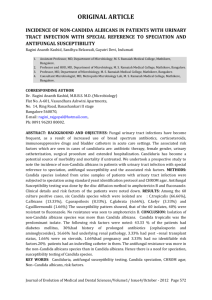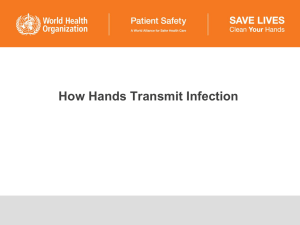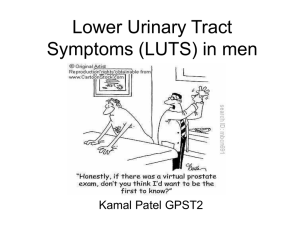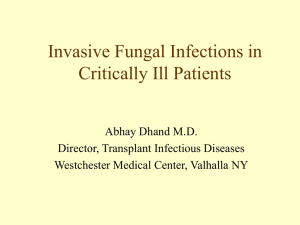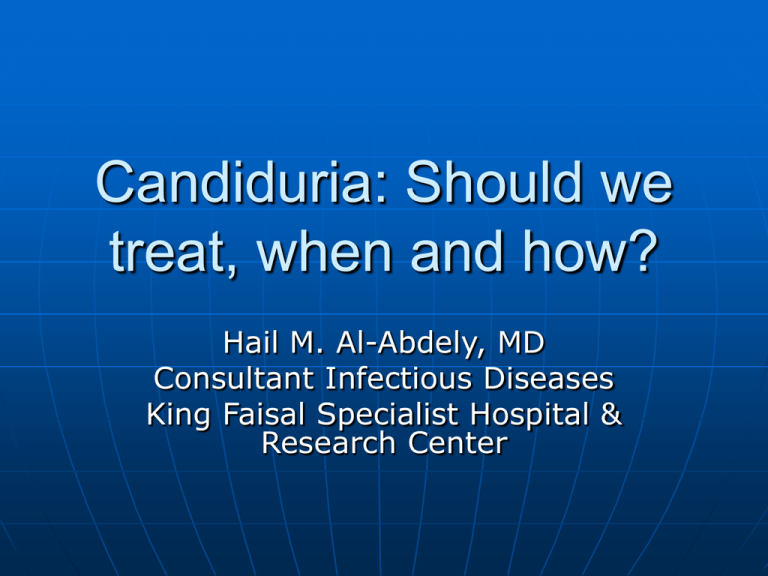
Candiduria: Should we
treat, when and how?
Hail M. Al-Abdely, MD
Consultant Infectious Diseases
King Faisal Specialist Hospital &
Research Center
Presentation Outline
How common is this problem?
Who gets it?
Why do we get candiduria?
Why should we treat it?
Who should be treated? and who should
not?
How to treat candiduria?
What are the current recommendations in
the management of candiduria?
Funguria or Candiduria
Candiduria = 99% of Funguria
How common is
Candiduria?
How common is this problem?
1910: Raffin was the first to report candiduria
1946: first well-documented case of candiduria.
Moulder MK. J Urol 1946, 56:420-426
1957: Cross-sectional study
• Candiduria in only 15 of 1500 patients.
• More than 50% of these 15 patients had diabetes mellitus and
were receiving antibiotics. Guze LB, Harley LD: Yale J Biol Med 1957,
30:292–305
1972: In a prospective study of healthy adults
• Urine cultures were positive in 10 of 440
• Culture results reverted to negative when clean catch
techniques were used
Schonebeck J, Ansehn S: Scand J Urol Nephrol 1972, 6:123–128
How common is Candiduria?
From 1980-1990 the nosocomial fungal infection
rate for urinary tract infections had risen from
9.0 to 20.5 per 10,000 hospitalized patients
Nosocomial bacteriuria or candiduria develops in
up to 25% of patients requiring a urinary
catheter for >7 days, with a daily risk of 5%
Candida species are now the commonest
organisms isolated from urine specimens in
surgical ICU patients.
Maki DG, Tambyah PA. 2001 Emerg Infect Dis;7:342-7
Lundstrom T, Sobel J. Clin Infect Dis. 2001 ;32:1602-7
Microbial pathogens causing nosocomial catheterassociated urinary tract infections in U.S. acute-care
hospitals, 1990-92
Hospital wide
Intensive care units
(% of total)
(% of total)
Escherichia coli
26
18
Enterococci
16
13
Pseudomonas
aeruginosa
12
11
Klebsiella and
Enterobacter
12
13
Candida spp.
9
25
Pathogens
Jarvis WR, Martone WJ. J Antimicrob Chemother 1992;29:19-24.
Who gets Candiduria?
Who gets it?
Diabetes mellitus
Antibiotics
Indwelling urinary catheters
Other risk factors.
• Extremes of age
• Female sex
• Immunosuppressive agents
• Use of iv catheters
• Interruption of the flow of urine
• Radiation therapy
Hamory BH. J Urol 1978, 120:444-448
Platt R, et al. Am J Epidemiol 1986, 124:977-985
Storfer SP, et al. Infect Dis Clin Pract 1994, 3:23-29
Phillips JR. Pediatr Infec Dis 1997, 16:190-194
Clin Infect Dis 2000, 30:14–18
Prospective Multicenter Surveillance Study of Funguria
in Hospitalized Patients
Study design:
• Prospective “observational” multicenter study
• No attempt was made to influence physicians' responses
to the report of a urine culture yielding yeast.
• Patients were followed until their discharge from the
hospital or for a maximum of 10 weeks.
•
•
•
•
•
•
•
Underlying conditions.
Urinary tract instrumentation.
Symptoms and signs of infection.
Urinalysis results.
Organisms isolated.
Treatment.
Outcomes.
Underlying diseases or conditions in 861
patients with funguria.
Underlying disease or condition
No. (%) of patients
Surgical procedure
450 (52.3)
Diabetes mellitus
336 (39)
Urinary tract disease
325 (37.7)
Neurogenic bladder
Prostatism, stones, or other obstructing lesions
Renal failure
Recurrent infection
Intrinsic renal disease
105 (12.2)
100 (11.6)
65 (7.5)
32 (3.7)
23 (2.7)
Malignancy
191 (22.2)
Malnutrition
146 (17)
Trauma
59 (6.9)
Neutropenia
37 (4.3)
Transplant
30 (3.5)
None
94 (10.9)
Kauffman CA, et al. Clin Infect Dis 2000, 30:14–18.
Urinary drainage devices in and procedures
undergone by 861 patients with funguria
Device or procedure
No. (%) of patients
Indwelling urethral catheter
668 (77.6)
Intermittent urethral catheterization
40 (4.6)
Suprapubic catheter
19 (2.2)
Nephrostomy drainage
19 (2.2)
Ileal conduit
9 (1)
Ureteral stent
10 (1.2)
None
145 (16.8)
Kauffman CA, et al. Clin Infect Dis 2000, 30:14–18.
Initial yeast isolates from urine 861
patients with funguria
Yeast isolates
No. (%) of patients
Candida albicans
446 (51.8)
Candida glabrata
134 (15.6)
Candida tropicalis
68 (7.9)
Candida parapsilosis
35 (4.1)
Candida krusei
9 (1)
Other
20 (2.3)
Undetermined
184 (21.4)
Kauffman CA, et al. Clin Infect Dis 2000, 30:14–18.
Why do we get
candiduria?
Why do we get candiduria?
Defense mechanisms against
development of candiduria?
• Flushing effect of urine
Normal urinary tract anatomy
Normal urinary tract function
• Balanced distribution of perineal flora
Causes of breach of defense
mechanisms?
Routes of entry of uro-pathogens to catheterized urinary tract
Maki DG, Tambyah PA. 2001 Emerg Infect Dis;7(2):342-7
Scanning electron micrograph of an infected catheter showing dense and
complex biofilm on the extraluminal surface
Maki DG, Tambyah PA. 2001 Emerg Infect Dis;7(2):342-7
Stark RP, Maki DG. N Engl J Med 1984;311:560-4.
Why should we treat
Candiduria?
Why should we treat it?
Symptomatic UTI
Ascending infection.
• Invasive cystitis
• Pyelonephritis
• Fungus ball
Hematogenous spread.
• Invasive candidiasis/candidemia
Candiduria as the only sign of invasive
candidiasis/candidemia
mycoses 42, 285–289 (1999)
Antifungal therapy for 861 patients with
funguria
Antifungal therapy
No. (%) of patients
Fluconazole only
161 (18.7)
Amphotericin B only
Bladder irrigation
Intravenously
Intravenously and by bladder
irrigation
100 (11.6)
30 (3.5)
11 (1.3)
Fluconazole and amphotericin B
Bladder irrigation
Intravenously
36 (4.2)
21 (2.4)
Other
11 (1.3)
None
491 (57.0)
Kauffman CA, et al. Clin Infect Dis 2000, 30:14–18.
Who is at risk of invasive
candidiasis from candiduria
• Patients with neutropenia
• Infants with low birth weight
• Patients with renal allograft
• ICU patients with multiple site colonization
• Patients who will undergo urologic manipulations
• Patients with significant urinary tract obstruction
Why should we
not treat it?
Why should we not treat it?
• Candiduria is discovered, rather than detected by deliberate
research
• Problems with diagnosis
Contamination:
• Urine specimens become contaminated with Candida during
the process of obtaining a urine
• Vulvo-vestibular colonization with Candida (10% 65%)
Colonization of the drainage device
• No reliable method for differentiating colonization from
infection.
• Asymptomatic adherence and settlement of yeast may result
in a high concentration of the organisms on urine culture
Infection
• Tissue invasion can not be determined
• Pyuria and colony counts
• Problems with outcome of Treatment
Benefits versus risks
Significance of High Colony Counts
and Pyuria
Colony counts
1956: Edward Kass defined significant
bacteruria as 100,000 cfu/ml. Kass EH: Trans
Assoc Am Physicians 1956, 69:56–64
1984: Stamm showed that cases of
pyelonephritis and symptomatic cystitis
had bacterial counts <100,000. Stamm WE:
Eur J Clin Microbiol 1984, 3:279–281.
Problems:
These definitions were conducted with E. coli
Never obtained for patients with urinary catheters
Never done with candida
Ability candida grow fast in urine can give high
counts even from contaminated specimen
Significance of High Colony Counts
and Pyuria
Pyuria
Indicates “inflammation” along the urinary
tract
Coupled with significant colony count
indicates “infection”.
Problems:
Catheter irritation can cause pyuria and
hematuria
Co-existing bacterial pathogen is common
Outcome of funguria in 530 patients for
whom outcome was documented
No. (%) of patients whose
funguria
Resolved
(n = 288)
Treatment
Persisted or
recurred
(n = 242)
None
117 (75.5)
38 (24.5)
Catheter removal only
41 (35.3)
75 (64.7)
Antifungal drugs, with or without
catheter removal
130 (50.2)
129 (49.8)
Kauffman CA, et al. Clin Infect Dis 2000, 30:14–18
Candidemia in 861 patients with Funguria
Candidemia found in 7 (1.3%) patients
• All had intravascular catheters and multiple
underlying diseases
Five of 7 patients with candidemia died
Two patients (0.4%) died because of
candidiasis
Kauffman CA, et al. Clin Infect Dis 2000, 30:14–18.
Sobel JD, et al.: Clin Infect Dis 2000, 31:209–210
Patients have 2 consecutive positive urine cultures for yeast
that were performed at least 24 h apart
Candiduria was defined as the presence in both cultures of
>1000 cfu/Ml.
Catheterized patients were eligible only if a follow-up
culture was positive after removal or replacement of the
catheter.
Asymptomatic candiduria was defined as absence of both
urinary symptoms and fever
Patients were stratified by catheterization status
Treatment 400mg loading followed by 200mg QD for 13
days
Urine cultures done at days 3, 7 & 14 and 2 wks after the
end of Rx
Sobel JD, et al.: Clin Infect Dis 2000, 30:19-24
Sobel JD, et al.: Clin Infect Dis 2000, 30:19-24
Sobel JD, et al.: Clin Infect Dis 2000, 30:19-24
Mortality
12 in fluconazole group and 14 in
placebo group (P=0.69)
No mortality was attributed to fungal
infection or treatment
No cases of candidemia
Sobel JD, et al.: Clin Infect Dis 2000, 30:19-24
How to treat candiduria?
How to treat candiduria?
Modify risk factors
Medical therapy
Candiduria
Repeat microscopy
and culture
No candida
Asymptomatic
(previously healthy)
Asymptomatic
(predisposed)
Stop
Look for predisposing
condition
Manage predisposing
condition
None found
Predisposing
Condition found
Candiduria resolves
Symptomatic
Systemic antifungal
Candiduria persists
Condition not serious
Observation
Unstable patients
Condition serious
Systemic antifungal
Adopted from: Fisher JF. Curr Infect Dis Reports 2000, 2:523-530
Medical Therapy
Polyenes
Amphotericin B (deoxycholate) - 1958
Liposomal amphotericin B (AmBisome) - 1997
Amphotericin Lipid Complex (ABLC) - 1996
Amphotericin Colloidal Dispersion (ABCD) - 1996
Azoles
Miconazole (intravenous) - 1979
Ketoconazole (P.O) - 1981
Fluconazole (P.O, intravenous) - 1990
Itraconazole (capsule, solution, intravenous) – 1992
Voriconazole (P.O, intravenous)-2002
Others
Griseofulvin - 1959
5-Flucytosine - 1972
Terbinafine – 1996
Caspofungin- 2001
Evolution of Treatment of Candiduria
candiduria
uncommon
and benign,
NO Rx
1960s
Slightly more
common
but benign,
treatment
toxic (Am B,
5-FC).
More common
but benign in
most patients,
imidazoles
are not
effective.
Am B toxic,
No Rx
Rx: Bladder
irrigation
with Am B
1970s
1980s
Common,
Candiduria
benign.
revisited.
Fluc safe and Era of EBM
effective.
Infrequent iv
Am B
Rx:
is safe.
Selective
Rx: FLUC,
therapy
bladder
irrigation
Iv Am B
1990s
2000
Medical Therapy of Candiduria (1)
Azoles
• Fluconazole
Advantage: Safe, high concentration in urine and effective
when compared with other therapies
Disadvantage: Limited spectrum because of resistance.
Effect is short-term
• Itraconazole:
Advantage: broad-spectrum
Disadvantage: Unfavorable pharmacokinetics, no
concentration in urine, limited data showed failures
• Ketoconazole:
More or less like itraconazole
• Voriconazole:
Advantage: broad-spectrum
Disadvantage: No data on efficacy
Medical Therapy of Candiduria (2)
Amphotericin B-based
• Intravenous AmB deoxycholate
Advantage: Broad-spectrum, prolonged concentration in
urine
Disadvantage: toxicity
• Topical AmB deoxycholate (bladder irrigation):
Advantage: broad-spectrum, low toxicity
Disadvantage: Local therapy of the bladder
• Lipid formulations of AmB:
Advantage: broad-spectrum, low toxicity
Disadvantage: No concentration in urine. Reports of many
failures
Medical Therapy of Candiduria (3)
Others
• 5-Flucytosine
Advantage: High concentration in urine, covers nonalbicans Candida
Disadvantage: Resistance and toxicity
• Caspofungin:
Advantage: broad-spectrum
Disadvantage: No data
• Terbinafine:
No data
Medical Therapy of Candiduria (4)
The main therapeutic modalities
• Systemic Fluconazole
Variable duration
• Systemic Amphotericin B
Short duration
• Topical Amphotericin B (Bladder irrigation)
Short duration
Continuous
Intermittent with catheter clamping
Oral fluconazole compared with bladder irrigation with amphotericin B
for treatment of fungal urinary tract infections in elderly patients
Jacobs et al. Clin Infect Dis 1996, 22:30–35
Prospective randomized trial
Elderly >65 years
Stratified by presence of indwelling urinary
catheter
Fluconazole 200mg loading them 100mg QD for 4
days versus AmB (5mg/ml) continuous bladder
irrigation for 5 days
109 (50 fluc versus 59 AmB irrigation)
Outcome:
• Eradication at 2 days after therapy
Findings
• Same baseline characteristics
Jacobs et al. Clin Infect Dis 1996, 22:30–35
Clearance of funguria with short-course antifungal
regimens: a prospective, randomized, controlled study
Leu H-S, et al. Clin Infect Dis 1995, 20:1152–1157
Study arms (each 30 adult patients who has 1000cfu/ml
candiduria in 2 consecutive cultures)
1.
2.
3.
4.
5.
6.
Untreated controls
Fluconazole: 200mg oral single dose followed by 100mg QD for 3
days
Iv Am B (15mg single dose)
Am B bladder irrigation for 3 days (5 mcg/ml intermittent Q8hrs)
Am B bladder irrigation for 3 days (100 mcg/ml intermittent Q8hrs)
Am B bladder irrigation for 3 days (200 mcg/ml intermittent Q8hrs)
Outcome measure:
•
Clearance of candiduria at day 1 and day 7
Clearance of funguria with short-course antifungal
regimens: a prospective, randomized, controlled study
Leu H-S, et al. Clin Infect Dis 1995, 20:1152–1157
Treatments
Clearance–Day 1
No. (%)
Clearance-Day 7
No. (%)
Untreated controls
No.=30
-
12/30 (40.0)
Fluconazole
No.=30
17/29 (58.6)
17/22 (77.3)
Iv Am B (single dose)
No.=30
16/29 (55.2)
18/25 (72.0)
Am B bladder irrigation
(5mcg/ml)
No.=30
23/28 (82.1)
9/21 (42.9)
Am B bladder irrigation
(100mcg/ml)
No.=30
26/30 (86.7)
13/19 (68.4)
Am B bladder irrigation
(200mcg/ml)
No.=30
25/30 (83.3)
15/22 (68.2)
Treatment of urinary Fungus Ball
Occurs mainly with obstructive
uropathy
Evidence comes only from anecdotal
reports.
• Surgical evacuation
• Irrigation of antifungal agents through
nephrostomy tubes
Amphotericin B
Fluconazole
5-flucytosine
IDSA Recommendations (1)
Asymptomatic candiduria rarely requires therapy.
Candiduria may, however, be the only microbiological
documentation of disseminated candidiasis.
Candiduria should be treated in
• symptomatic patients,
• patients with neutropenia,
• infants with low birth weight
• patients with renal allografts
• Patients who will undergo urologic manipulations
Short courses of therapy are not recommended; therapy for 7–14
days is more likely to be successful.
Removal of urinary tract instruments or placement of new devices
may be beneficial.
IDSA Recommendations (2)
Treatment with fluconazole (200 mg/day for 7–14 days) and with
amphotericin B deoxycholate at widely ranging doses (0.3–1.0
mg/kg per day for 1–7 days) has been successful.
Oral flucytosine (25 mg/kg q.i.d.) may be valuable for eradicating
candiduria in patients with urologic infection due to non-albicans
species of Candida.
Bladder irrigation with amphotericin B deoxycholate (50–200
mcg/mL) may transiently clear funguria but is rarely indicated
Even with apparently successful local or systemic antifungal
therapy for candiduria, relapse is frequent, and this likelihood is
increased by continued use of a urinary catheter.
Persistent candiduria in immunocompromised patients warrants
ultrasonography or CT of the kidney
Conclusion
Generally candiduria is a benign condition that almost always
associated with urinary instrumentation and may not warrant therapy
Treatment of asymptomatic candiduria in non-neutropenic
catheterized patients has never been shown to be of value.
No diagnostic criteria for urinary candidiasis
Candiduria in neutropenic patients, critically ill patients in ICUs,
infants with low birth weight, and recipients of a transplant may be an
indicator of disseminated candidiasis.
Treatment of persistently febrile patients who have candiduria but
who lack evidence for infection at other sites may treat occult
disseminated candidiasis.
When treatment is indicated, systemic antifungal therapy should be
used.
Until better diagnostic techniques become available, the decision to
initiate antifungal therapy remains mostly one of clinical judgment.

